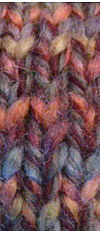Slip-stitch knitting — is a family of knitting techniques that use slip stitches to make multiple fabrics simultaneously, to make extra long stitches, and/or to carry over colors from an earlier row. Contents 1 Basic methods 2 Double knitting with slip stitches 3… … Wikipedia
Drop-stitch knitting — is a knitting technique for producing open, vertical stripes in a garment. The basic idea is to knit a solid fabric, then (deliberately) drop one or more stitches (i.e., draw a loop out from the loop below it, and so on repeatedly), producing a… … Wikipedia
Knitting — Knit redirects here. See also KNIT and Knitted fabric. Knitting is a method by which thread or yarn may be turned into cloth. Knitting consists of loops called stitches pulled through each other. The active stitches are held on a needle until… … Wikipedia
Knitting needle — Bamboo knitting needles A … Wikipedia
Continental knitting — Knitting with the yarn in one s left hand is commonly referred to as Continental knitting, German knitting, European knitting, or left hand knitting. Unlike English knitting, the yarn is held in the left hand; the motion of bringing the yarn… … Wikipedia
Weaving (knitting) — In knitting, weaving is a family of techniques for introducing extra yarn(s) into a knitted fabric without knitting them. The extra yarns almost always follow the horizontal rows (courses) of knitting and, if visible, resemble a woven texture.… … Wikipedia
Decrease (knitting) — A decrease in knitting is a reduction in the number of stitches, usually accomplished by suspending the stitch to be decreased from another existing stitch or by knitting it together with another stitch. Contents 1 Methods of Single Decreasing… … Wikipedia
Row counter (hand knitting) — Clover on needle row counters from Japan, 2000 2010 A row counter for hand knitting is a tally counter for counting rows or courses worked, for counting stitch pattern repetitions, or for counting increases or decreases of the number of stitches… … Wikipedia
Double knitting — is a form of knitting in which two fabrics are knit simultaneously with two yarns on one pair of needles. The fabrics may be inseparable, as in interlock knitted fabrics, or they can simply be two unconnected fabrics. In principle, an arbitrary… … Wikipedia
Combined knitting — or combination knitting is a style that combines elements of Eastern style knitting with the Western techniques. By wrapping the yarn the opposite way while purling, the knitter changes the orientation of the resulting loops; then the next row s… … Wikipedia

